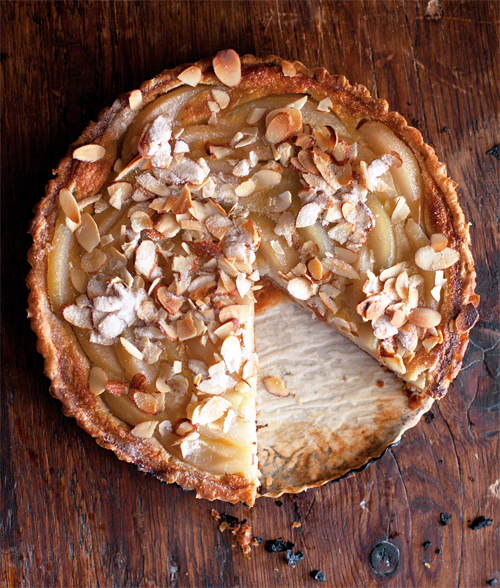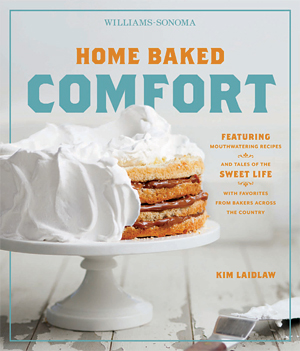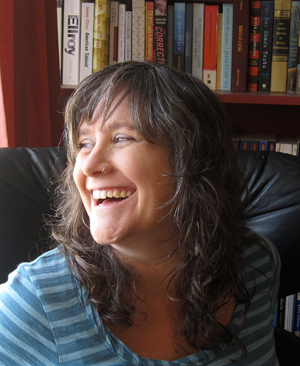Nothing's too daunting; nothing requires much more than the usual home-kitchen setup of cake pans, pie pans, and baking sheets. (Do pick up some buttermilk, sour cream, and a microplane citrus zester before you start, however.) And, like the pictures, the recipes are flavorful and engaging; you could serve them at a bake sale or a dinner party and earn the same enraptured, nothing-but-crumbs-on-the-plate reaction. As an dedicated home baker myself, I caught up with Laidlaw at her home in Noe Valley on the eve of her book's release to find out how it all came together.
First of all, how did Laidlaw go from editor to writer? Last year, as part of her job as an editor at Weldon Owen, a San Francisco-based publisher which creates Williams-Sonoma's branded books in addition to other titles, Laidlaw was tasked with finding a writer/recipe developer for a planned home-baking book. (Full disclosure: As a freelance writer and editor, I have worked with Laidlaw and others at Weldon Owen professionally over the years.) The more she thought about the project, the more she realized, "This is what I do!" It wasn't just that she was a lifelong home baker; before becoming a full-time cookbook editor, she'd graduated from CCA's Baking and Pastry program, then worked as a baker at Oakland's La Farine bakery. She knew, having edited dozens of Williams-Sonoma cookbooks, just how important it was to produce the sort of meticulously tested, foolproof recipes that the brand was known for, and felt sure that she had both the baking and writing chops to do it.
But just being an employee didn't give her an automatic in; like any other potential author, she had to present a detailed proposal outlining her recipes, her approach, and why she'd be the best choice for the job. It worked, and with a pressing deadline looming, she got busy whipping up layer cakes and butterscotch puddings in her cramped home kitchen, where there was no Viking stove or Sub-Zero fridge, just the usual generic appliances of any apartment rental.
Writing the book happened to coincide with Laidlaw's pregnancy--which translated into a mostly ravenous appetite. Laidlaw laughed when asked about the rapturous headnotes describing each recipe. "I wrote it while I was pregnant! I would find myself eating half the batch of scones," in one sitting, and everything she made tasted like the best thing ever. Her husband, who had recently started a new job, earned instant popularity around the office as the guy with the recipe-testing wife; "crazy amounts" of tester cookies, brownies, cakes and more went with him to work almost daily.
Now, with the book just out, Laidlaw is still baking, only this time with her young daughter Poppy tucked in a carrier across her chest. "We bake together. She loves it!" Laidlaw said, and it's true: during my visit, Poppy was giggling and smiling, her eyes following her mother's deft movements as Laidlaw whisked together the batter for Pumpkin-Brandy Bread, (see recipe below) a specialty of her own mother's. The finished product, still hot out of the oven, wasn't overly boozy, but it did have a wonderfully grown-up whiff of brandy to it, making it perfect for afternoon tea, especially during the holidays. Her trick for cooking while parenting? "I cook everything in tiny steps, so I can stop anytime."
Some of her favorite recipes in the book are ones that come from her own family traditions, like the Christmas Breakfast Pie, something that she, her mother, and her brother make every Christmas, no matter where they are, and the Beer Rolls, originally made with just Bisquick and beer. "My brother and I thought that was so cool, baking with beer!" she said, which led her to develop a similar, from-scratch recipe that captured the appeal of the original.
She finds her inspiration in things she sees in bakeries, in restaurants, in flavor combinations she imagines. "I'm kind of a lemon freak. There's a crazy amount of citrus zest in the book, it's kind of obnoxious!" As for her favorite thing to bake, "definitely pies and galettes," although she especially admires bread bakers. "It's a real skill that can be kind of hard to do in a home kitchen. But it's so basic and satisfying." Flipping through the recipes, it's clear that Laidlaw has a taste for fruit; there are wonderful, not-too-sweet fruit desserts in every chapter. Pear Custard Tart (see recipe below), inspired by a old Julia Child recipe, comes out delectably elegant, and the vanilla-poached pears are good enough to eat on their own. Laidlaw prefers a hint of salt to too much sweetness, and few recipes seem overly gooey or rich.
It's an easy, appealing book, reflecting Laidlaw's own opinion, based in experience as both a professional and a home baker, that baking isn't that hard, and that its reputation as the stern, inflexible taskmistress of the kitchen is ill-deserved. Once you know the basic chemistry of baking and have a feel for how different baked goods work, you can mess around with your recipes, more than you might think.
"The whole point of the book is to get more people baking, get them to see that it's not so daunting, make it approachable and fun."
That said, are there common pitfalls that new bakers might avoid?
- "People overwork pastry and biscuit dough too much, then they get frustrated," when it doesn't turn out as flaky or fluffy as they hoped.
- In making quick breads, like muffins, that are raised with baking powder and/or baking soda, "some people mix the batter and then just let it sit," rather than getting it into the oven, pronto. Once the batter is mixed, the chemical leavening process starts, and so delaying the baking process can produce a flat result.
- And finally, people frequently overbake, paying more attention to the minutes specified in the recipe than to what their senses tell them about the finished product.
It all comes down to not following recipes too rigidly.
"I want people to relax and enjoy it, be more flexible. Not all ingredients are the same, and things change depending on how cold, hot, or wet the day is. Just relax! I think it's the best thing you can do for somebody, to bake something for them."

Recipe: Pear-Custard Tart
The first recipe from Julia Child that I ever made was her French custard apple tart, which I still love to this day. This delicately flavored tart, filled with vanilla-poached pears and brandy-spiked custard and topped with sugary toasted almonds, is an ode to her and that memorable dessert.
Ingredients:
Flaky Pie Dough for single crust (see recipe below)
for the poached pears
3⁄4 cup (6 oz⁄185 g) Sugar
3 ripe but firm pears, preferably Bosc, peeled, quartered, and cored
Peel of 1 orange, removed in strips with a vegetable peeler
1⁄2 vanilla bean
1 large egg
1⁄4 cup (2 oz⁄60 g) sugar plus 1 tbsp
3 tbsp all-purpose flour
1⁄2 cup (4 fl oz⁄125 ml) heavy cream
1 tsp pure vanilla extract or 2 tbsp brandy (optional)
Pinch of kosher salt
1⁄4 cup (1 oz⁄30 g) sliced almonds, lightly toasted
makes one 10-inch (25-cm) tart
Instructions:
Prepare the flaky pie dough and chill as directed. (see recipe below)
To poach the pears, cut a circle of parchment paper that will fit in a medium saucepan. Cut a small circle in the middle of the parchment. In the saucepan, bring 3 cups (24 fl oz/750 ml) water and the sugar to a boil over high heat. Reduce the heat to medium and add the pears and orange peel. Split the vanilla bean and scrape out the seeds with the back of a paring knife; add the pod and seeds to the saucepan. Lay the parchment in the saucepan to submerge the pears. Adjust the heat so that the liquid simmers gently and poach the pears until just tender, about 15 minutes. Let cool in the poaching liquid.
Position a rack in the middle of the oven and preheat to 400°F (200°C). On a lightly floured work surface, roll out the dough to a circle about 13 inches (33 cm) in diameter. Transfer the dough to a 10-inch (25-cm) tart pan with a removable bottom and ease into the pan. Trim away any excess dough. Line the tart shell with foil and fill with pie weights or dried beans. Bake until the crust is dried out and just starting to color a bit, about 20 minutes. Remove the foil and weights. Let cool. Reduce the oven temperature to 350°F (180°C).
Cut each pear quarter lengthwise into 4 slices, then lay most of the pear slices in the crust in an overlapping circle close to the rim. Use the remaining slices to fill the middle.
In a bowl, beat together the egg and the 1⁄4 cup sugar until thick and pale. Beat in the flour and then the cream, vanilla, if using, and salt. Pour evenly over the pears. Bake until the custard starts to puff up, about 10 minutes. Sprinkle the toasted almonds and remaining 1 tablespoon sugar over the top of the tart. Continue to bake until the custard is set and lightly browned, 15–20 minutes. Let cool on a wire rack until warm or room temperature before slicing and serving.
Baker's Note:
To turn this into an apple tart, gently sauté 3 peeled, cored, and sliced apples in 1 tablespoon butter until they just start to become tender. Spread evenly in the partially baked crust, pour over the custard, and proceed with the recipe from there.
Recipe: Flaky Pie Dough for Single Crust
Ingredients:
1 1⁄4 cups (61⁄2 oz⁄200 g) all-purpose flour
1⁄4 tsp kosher salt
1⁄2 tsp sugar (optional; omit if making a savory dish)
7 tbsp (31⁄2 oz⁄105 g) very cold unsalted butter, cut into cubes
5 tbsp (3 fl oz⁄80 ml) ice water, plus more if needed
makes enough for one 9-inch (23-cm) pie or tart
Instructions:
In the bowl of a food processor, stir together the flour, salt, and sugar, if using.
Sprinkle the butter over the top and pulse for a few seconds, or just until the butter is slightly broken up into the flour but still in visible pieces.
Evenly sprinkle the water over the flour mixture, then process just until the mixture starts to come together.
Dump the dough into a large lock-top plastic bag, and press into a flat disk. Refrigerate the dough for 30 minutes or up to 1 day, or freeze for up to 1 month.
Recipe: Pumpkin Brandy Bread
Growing up, I remember my mom baking this bread in metal coffee cans and how I loved the funny round shape. This recipe calls for a lot of brandy, more than you might be comfortable with, but it is honestly the best pumpkin bread I have ever tasted. You can cut the brandy in half if you want.
Ingredients:
4 large eggs
2 cups (1 lb⁄500 g) granulated sugar
1 cup (7 oz⁄220 g) firmly packed light brown sugar
1 cup (8 fl oz⁄250 ml) canola oil
2⁄3 cup (5 fl oz⁄160 ml) brandy
1 can (15 oz⁄470 g) pumpkin puree
3 1⁄2 cups (171⁄2 oz⁄545 g) all-purpose flour
2 tsp baking soda
1 1⁄2 tbsp pumpkin pie spice
1 tsp kosher salt
1⁄2 cup (2 oz⁄60 g) chopped pecans or walnuts, lightly toasted (optional)
makes 2 loaves
Instructions:
Position a rack in the middle of the oven and preheat to 350°F (180°C). Generously butter two 9-by-5-inch (23-by-13-cm) loaf pans.
In a large bowl, whisk together the eggs and sugars. Add the oil, brandy, and pumpkin and whisk to combine. In another bowl, sift together the flour, baking soda, pumpkin pie spice, and salt. Add to the pumpkin mixture along with the nuts, if using, and stir to combine.
Divide the batter between the prepared pans and bake until richly golden brown and a toothpick inserted into the center of a loaf comes out clean, about 50 minutes. Let cool slightly in the pans, then turn the loaves out onto a wire rack to cool.
Baker's Note:
Baked in smaller, individual-sized loaf pans, this decadent bread makes excellent mini gifts during the holidays. Divide the batter between the pans. The baking time might vary depending on the size of the pans. Once the baked loaves have cooled, wrap each one in colorful cellophane, tie a ribbon around it, and bring on the good cheer.
 The buttery-sweet smell of morning muffins, fresh from the oven. A lavishly frosted kid's birthday cake, awaiting its candles. A sticky spoonful of chocolate-chip cookie dough snuck from the bowl. What can be more comforting coming out of the kitchen than home-baked treats? Home Baked Comfort, Williams-Sonoma's latest addition into its line of comfort-food cookbooks, is very aptly named.
The buttery-sweet smell of morning muffins, fresh from the oven. A lavishly frosted kid's birthday cake, awaiting its candles. A sticky spoonful of chocolate-chip cookie dough snuck from the bowl. What can be more comforting coming out of the kitchen than home-baked treats? Home Baked Comfort, Williams-Sonoma's latest addition into its line of comfort-food cookbooks, is very aptly named.
